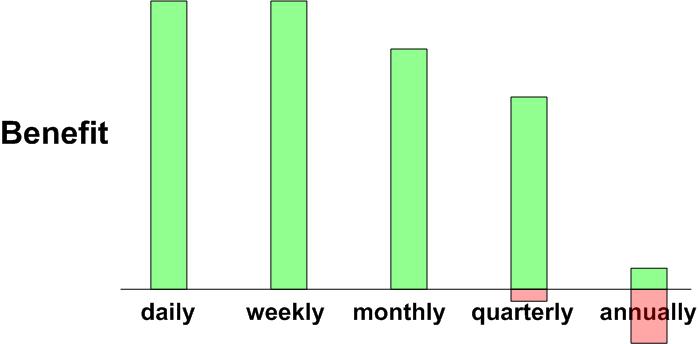Daily, monthly Vitamin D had similar great benefits, more than 6 months needed – RCT
Vitamin D Daily versus Monthly Administration: Bone Turnover and Adipose Tissue Influences
Nutrients 2018, 10(12), 1934; https://doi.org/10.3390/nu10121934 Published: 6 Dec 2018
 Notion of Vitamin D benefit vs dosing frequency for > 50 nanograms
Notion of Vitamin D benefit vs dosing frequency for > 50 nanograms
 ---
* Vitamin D every 25 days may be BETTER than daily – RCT May 2018
* Monthly 100,000 IU of vitamin D is safe (and may be better than daily) – RCT Aug 2018
* Vitamin D given weekly better than daily (Nursing home, 5,600 IU weekly) – Aug 2018
* Monthly vitamin D dosing had higher response than 3 per month – RCT Jan 2018
* Monthly vitamin D dosing is better than daily dosing for children and elderly (more likely to be taken) – June 2017
* Far more Vitamin D in breast milk from a 150,000 IU dose than from daily 5,000 IU – RCT May 2018
* * Intervention - non daily category listing has items along with related searches**
* 22 diseases proven to be prevented/treated by biweekly Vitamin D
* 10 additional diseases with weekly Vitamin D
---
* Vitamin D every 25 days may be BETTER than daily – RCT May 2018
* Monthly 100,000 IU of vitamin D is safe (and may be better than daily) – RCT Aug 2018
* Vitamin D given weekly better than daily (Nursing home, 5,600 IU weekly) – Aug 2018
* Monthly vitamin D dosing had higher response than 3 per month – RCT Jan 2018
* Monthly vitamin D dosing is better than daily dosing for children and elderly (more likely to be taken) – June 2017
* Far more Vitamin D in breast milk from a 150,000 IU dose than from daily 5,000 IU – RCT May 2018
* * Intervention - non daily category listing has items along with related searches**
* 22 diseases proven to be prevented/treated by biweekly Vitamin D
* 10 additional diseases with weekly Vitamin D
📄 Download the PDF from VitaminDWiki
Luca Dalle Carbonare 1,2, Maria Teresa Valenti 1,2,* , Francesco del Forno 1,2, Giorgio Piacentini 3 and Angelo Pietrobelli 3,4
1 Clinic of Internal Medicine, Section D, Department of Medic89e, University of Verona, 37134 Verona, Italy
2 Specialized Regional Center for Biomolecular and Histomorphometric Research for Skeletal and Degenerative Diseases, 37134 Verona, Italy
3 Department of Surgical Sciences, Dentistry, Gynecology and Pediatrics, Pediatric Division, University of Verona, 37134 Verona, Italy
4 Pennington Biomedical Research Center, Baton Rouge, LA 70808, USA
Vitamin D is involved in bone metabolism and in many various extra-skeletal diseases such as malabsorption syndromes, cardiovascular and metabolic diseases, cancer, and autoimmune and neurological diseases. However, data on the optimal route of administration are not consistent. The aims of our study were to analyze not only the influence of daily vs. monthly administration of vitamin D on bone metabolism and bone turnover, but also the effects of different routes of administration on fat mass in a cohort of adults with low levels of 25(OH) vitamin D3 at baseline. We analyzed 44 patients with hypovitaminosis at baseline and after six months of two different regimens of administration: seven drops ( 1750 IU)/day vs. 50,000 IU/month . We found that the two regimens were equivalent; 36 out of 44 patients reached the normal range of vitamin D after six months of treatment. Interestingly, the main determinant of vitamin D at baseline was the waist circumference.
In addition, 22 patients treated by monthly regimen were evaluated after 18 months of treatment. At the end of follow-up, patients showed normal levels of vitamin D, with increased calcium levels and decreased bone turnover. Waist circumference also decreased. Our results support the efficacy of vitamin D3 given monthly both for correcting hypovitaminosis and for maintaining vitamin D levels. The relationship between serum 25(OH)vitamin D3 concentration and waist circumference supports vitamin D having a protective role in the current setting, since waist size is directly associated with the risk of cardiovascular and metabolic diseases
